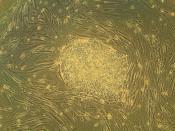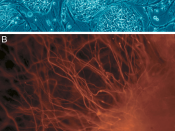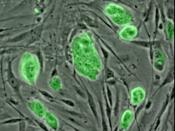Table of ContentsIntroduction and Historical Perspective2Scientific Background2Research Methodology4List of Interviews Conducted5S Curve Analysis6Development Cycle7Research7Testing and Approval8CommercializationPatentsPotential MarketsDriversHow Big?The Next Big ThingiPS CellsMacular DegenerationAdvanced MelanomaRoadblocks and RisksScientificLegislativeBusiness ModelProposed Business ModelThoughts and ConclusionsTeam OrganizationReferencesAppendixIntroduction and Historical PerspectiveStem cells have recently been in the limelight for a variety of political and ethical reasons. Yet, aside from these largely provoking political events, stem cells as a scientific field has been extremely successful and groundbreaking. From its initial discovery in 1963 by McCulloch and Till, research on stem cells has taken off at a very fast rate. In 1981, the first mouse embryonic stem cells were derived by Martin Evans, Matthew Kaufman, and Gail Martin1.,2 It was at this time that the term embryonic stem cell was coined by Martin. Eventually, James Thomson derives the first human embryonic cell line in 1998.3 It took 18 years to isolate the first mouse embryonic stem cells, and then another 17 years to isolate human embryonic stem cells. It seems that the rate of development of stem cells is getting faster and faster, as over the last 10 years, many new breakthroughs have been developed. Currently, it is an exciting time to be in the field of stem cell research.
Scientific BackgroundStem cells are cells that are found in most organisms which by definition must be self-renewing and pluripotent. This means that they must be able to undergo cell division through mitosis as well as differentiate into many different types of cells. These two factors allow stem cells to replenish certain damaged or missing cells in many different tissue types. Because of this regeneration property, stem cells also offer a possible treatment to many degenerative and metabolic diseases, such as Parkinson's disease and diabetes, where simple cell therapy does not work. However, since the field of stem...


